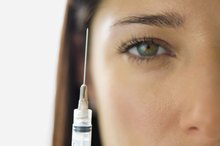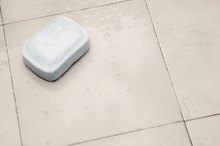Side Effects of a Chemical Face Peel
Chemical peels use one of several substances to remove the uppermost layers of skin, revealing fresher cells below. In general, the higher the concentration of the active ingredient in a chemical peel, the deeper into the skin the product goes. In addition, the higher the concentration of the active ingredient, the greater the risk of side effects.
Redness, Swelling and Itching
Redness, swelling and itching are the most common side effects of a chemical peel. This effect, which looks and feels like a sunburn, can occur regardless of the type of peel. Chemical peels range from over-the-counter home peels to those performed under anesthesia in a medical facility. Although home peels contain very low concentrations of the exfoliating ingredient, people with sensitive skin can experience these side effects. Estheticians and doctors offer a variety of chemical peels with higher concentrations of exfoliants than those found in home peels. Redness, swelling and itching associated with a chemical peel typically resolves as the skin heals.
- Redness, swelling and itching are the most common side effects of a chemical peel.
Skin Color Changes, Cracking and Peeling
Chemical Peels for Scars
Learn More
Trichloroacetic acid, called TCA, is a common ingredient in chemical peels that are meant to reach deeper into the skin. TCA peels, which are usually applied by a doctor, help correct more noticeable wrinkles and uneven skin coloring. Possible side effects of this more extensive peel include loss of skin color, darkening of the skin, cracking and peeling.
Generally, skin starts to darken beginning on the third or fourth day after treatment. As it darkens, the skin dries out, cracks and then begins to peel, revealing fresher looking skin beneath. This process can last from 4 to 7 days and can cause irritation. Infection is a possible secondary side effect of the cracking and peeling process.
- Trichloroacetic acid, called TCA, is a common ingredient in chemical peels that are meant to reach deeper into the skin.
Infection and Scarring
Infection and scarring can occur with any chemical peel. Because the protective, outer layer of skin is removed during the process, the skin is more vulnerable to infection. Although uncommon, infections can be caused by viruses, bacteria or fungi. In general, the risk for infection and scarring increases according to the depth of the peel. Proper care after a chemical peel can greatly lessen the chance of infection and scarring 1.
- Infection and scarring can occur with any chemical peel.
- In general, the risk for infection and scarring increases according to the depth of the peel.
Related Articles
References
- American Academy of Dermatology: Chemical Peeling: What to Expect Before, During, and After
- Comprehensive Dermatologic Drug Therapy; Stephen E. Wolverton
- O'connor AA, Lowe PM, Shumack S, Lim AC. Chemical peels: a review of current practice. Australas J Dermatol. 2018;59(3):171-181. doi:10.1111/ajd.12715
- Castillo DE, Keri JE. Chemical peels in the treatment of acne: patient selection and perspectives. Clin Cosmet Investig Dermatol. 2018;11:365–372. doi:10.2147/CCID.S137788
- Soleymani T, Lanoue J, Rahman Z. A practical approach to chemical peels: a review of fundamentals and step-by-step algorithmic protocol for treatment. J Clin Aesthet Dermatol. 2018;11(8):21–28.
- Cleveland Clinic. Chemical peels: what to expect.
- Cleveland Clinic. Chemical peels: how to prepare.
- Stanford Healthcare. Techniques: our approach to chemical skin peels.
- Cleveland Clinic. What results can I expect?.
Writer Bio
Katherine Mariaca is a professional freelance journalist who specializes in alternative and complementary medicine, and skin and body care treatments. A longtime spa director and VP of skin care companies, Mariaca developed products and services for the spa industry. She earned a B.S. from Tufts and an M.F.A. from Lesley.









